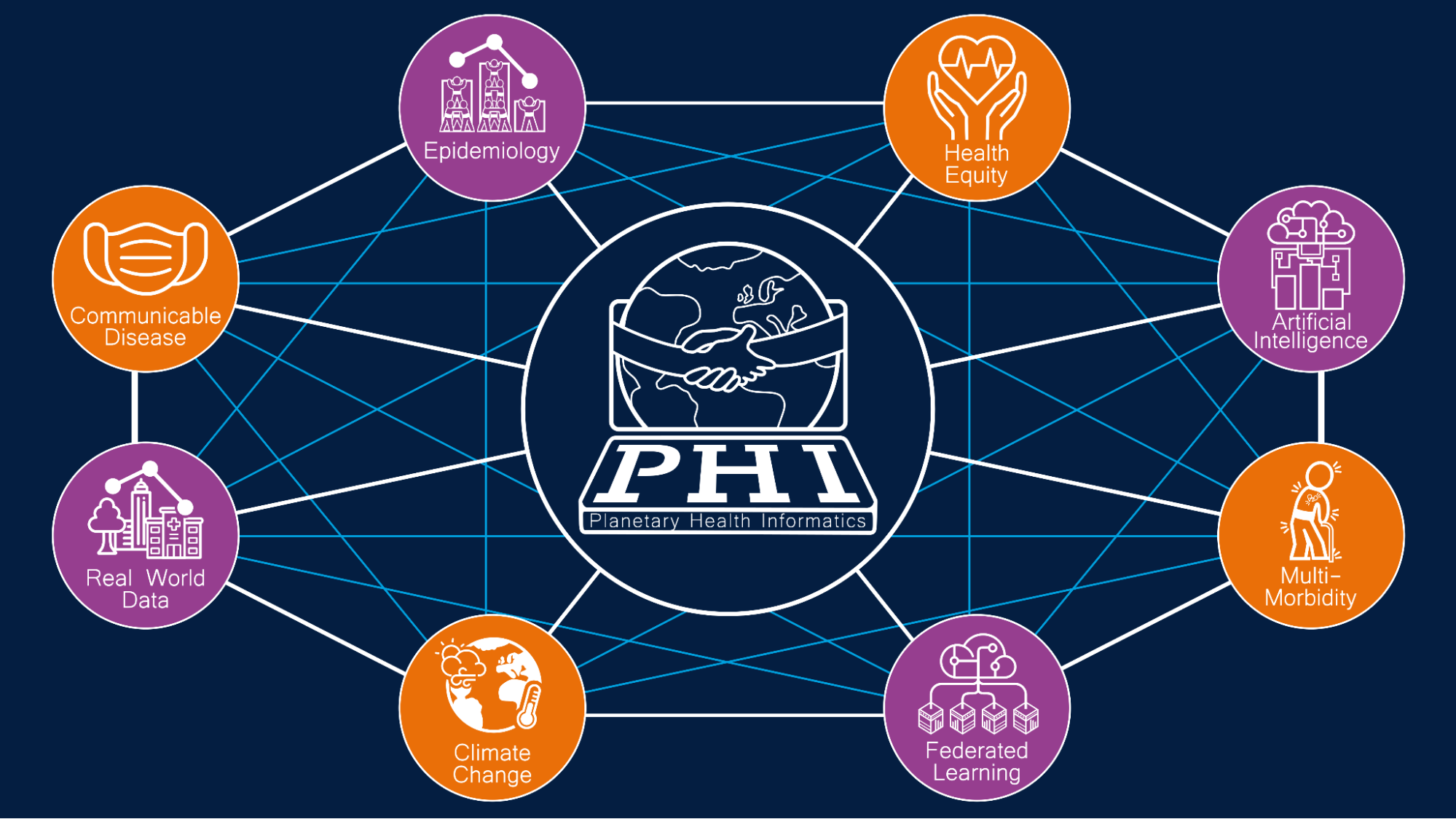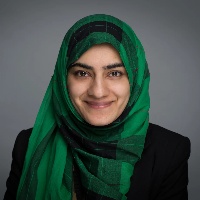AI for Public and Planetary Health
Better data, better models, better health for all

Dr. Sara Khalid is an Associate Professor and Head of the Oxford Planetary Health Informatics Lab in the Centre for Statistics in Medicine at Oxford University. She is also a Senior Research Fellow in Biomedical Data Science and Health Informatics and a National Geographic Explorer in Remote Monitoring and Machine Learning.
She talks here about her work in climate and planetary health with CCAI’s Public Health Lead, Sarah Skenazy. You can hear more from Professor Khalid in the recording of her recent CCAI Summer School lecture on climate and health. Sign up for our newsletter to be alerted to the release of the session!
Interview with Dr. Sara Khalid
Skenazy: What is the relationship between climate change and health—how is climate change impacting global public health and what can we anticipate happening in the future?
Khalid: Climate and health are inextricably linked, both directly and indirectly. In fact climate change has been recognised as one of, if not the, greatest public health challenges of the 21st century.
Why is that? We know that the environments we are exposed to—natural, living, and social—lead to the majority of diseases, both chronic and communicable. The World Health Organisation (WHO), which has been monitoring this for a long time, estimated that one in four deaths around the world are linked to the environment. Climate change is multiplying this threat. Take the example of extreme weather – extreme heat and cold temperatures are associated with more than 5 million excess deaths every year. On top of the human cost, climate change has a significant economic cost, with WHO estimates suggesting over $4bn/year.
As the Earth’s vital signs continue to steer off course, climate-induced disasters, biodiversity loss, and extreme weather events are on the rise around the world. Heatwaves, for example, are becoming longer-lasting, more intense, and more frequent, and are amongst the deadliest extreme weather events. Within the last decade, extreme heat events have triggered public health red-alerts globally. Over 30 countries have declared climate emergencies. Moving forwards, there is an imminent and growing need to adapt our health solutions and care systems so the health of everyone, especially those most vulnerable, is protected.
Skenazy: Your work with the Planetary Health Informatics Lab sometimes frames the interdependent risks facing the earth and all beings on it in terms of a ‘planetary health crisis.’ Can you explain how planetary health relates to global public health, health equity, and related frameworks (like climate justice) across the public and population health field internationally?
Khalid: Planetary Health is simple in concept, it broadly refers to the study of the impact of human-induced disturbances in the planet’s ecosystem on human health itself. So the focus is still very much on human health and its intersectional determinants, although the causes are not limited to traditional physiological and genetic risk factors but rather the entire exposome, which encompasses all environmental exposures that an individual encounters throughout their life, and how these exposures impact both biology and health.
Climate justice is important because not everyone is equally affected by climate change. Within a given society, for instance, evidence indicates that the elderly, children, pregnant people, outdoor workers, and unhoused people are disproportionately at higher risk. The recent ruling by the European Court of Human Rights in favour of elderly women highlights the importance of recognising a link between human rights and climate change.
But there is still much we don’t fully understand. Specific knowledge gaps include how individual-level health outcomes of at-risk groups are affected, and how these impacts vary with factors like socio-demographics, genetics and/or ethnicity, and different climatic regions. These gaps can transfer into health adaptation practices and policy-making.
On another level, although economically rich countries have historically generated more greenhouse gas emissions, it is some of the most economically poor regions that have some of the highest climate vulnerability indices. The same under-resourced countries often have overburdened fragile healthcare systems, and so that leads to injustice in public health and health inequity more broadly. On the flip side, countries where people may be less acclimatised for instance to extreme heat or are historically less exposed to infectious diseases may be inequitably at risk because of a lack of both risk awareness and supportive infrastructure. So it is a multi-faceted complex global issue.
Skenazy: What is the role of artificial intelligence in addressing the planetary health crisis?
Khalid: In the field of healthcare, AI can be used as a force for good. One of its most successful applications has been in traditional medical imaging, by helping doctors to see what the naked eye cannot. In this way, it is helping treat cancers, cardiometabolic diseases, etc. Although it’s still early days for many medical large language models (LLMs), this state-of-the-art AI is starting to show promise, for example, by reducing the time it takes doctors to go through patient notes and helping with front-line decision-support—however, a lack of representative data leads to inequitable benefits (Davis N., Winawer N.). AI is also going to be key in improving coordination and reducing response time in disaster relief and rescue efforts, as they become more frequent with climate change. In the climate crisis, AI-based early warning systems for heatwaves, for example, are already in place in cities like Shanghai and Philadelphia, and others are emerging. Similarly for flood prediction, efforts by Google and others have led to flood prediction systems in places like India and Bangladesh to help plan for and respond to extreme monsoons. However, as with any technology, AI is meant to augment human/expert knowledge and not to replace it. This is particularly important in healthcare where people’s lives and health are involved in safety-critical situations.
Skenazy: How might AI exacerbate health inequity? Alternatively, how might it support solutions to limit harm and reduce inequitable impacts?
Khalid: AI depends on data, which means data can be the Achilles heel of AI. Let’s take the example of a clinical risk prediction AI. If there are biases in the underlying data or underlying algorithmic processes, the resulting AI tool can misestimate a real person’s health risks. At an individual level, this impacts a person’s health outcomes, and at a societal level, it can over- or under-prioritise entire population sub-groups. We have seen numerous examples of this, for example, when healthy black males were wrongly invited for COVID-19 screening, mothers-to-be of colour routinely have disproportionately been offered C-section procedures, and numerous other examples across the clinical spectrum. This is why it is important to input good data, and data that are representative. In the Ethnicity, Equity and AI projectfor example, for the first time, self-identified ethnicity data for over 60 million people has been completed in their electronic health records. The idea is that by using such representative data resources, health research can become less biased and scientists can build more representative health AI tools in future.
The Global Grand Challenges in AI has done some good work to showcase examples of where and how AI can be catalysed for reducing global health inequities. One such project that I have had an opportunity to contribute to looks at the issue of health data poverty and tests off-the-shelf LLMs for bias when applied to low- and middle-income country (LMIC) settings. We are starting to see that existing foundation models trained predominantly on data from traditionally data-rich countries in the Global North are biased but can be adapted to local settings in the Majority World by responsible and fair fine-tuning to local data. It’s important to keep in mind that data too has a carbon footprint. So the need for green AI cannot be overstated. Efforts by CCAI and others in the community towards this are also commendable.
Skenazy: Your work with the Planetary Health Informatics Lab is demonstrating how the mash-up of climate and health data can help address some of the challenges around equitable health for people and the planet. What are some of the challenges, and can you talk about any unique considerations for researchers when bringing together health data with other types of data—from satellite monitoring, environmental, etc.—in machine learning analyses? How might these considerations vary in different international contexts?
Khalid: The first thing to be said is that this is a young field, albeit a fast emerging one. The good news is that the compute power and high-performance infrastructure exist. Linking health and satellite data for example is complex, but with advanced data curation approaches it is achievable. Sometimes it is the seemingly straightforward issues that can be the most challenging. Let me give you one simple example—there is no universal definition of a heatwave–because what falls within and outside a “normal” temperature range differs from region to region. This may seem trivial, but getting it wrong can lead to biased models that may be appropriate for use in one region but not in others. So in many ways, it all boils down to good data. So here in the Planetary Health Informatics Lab we have a motto of “better data, better models, better health for all”.
Skenazy: Considering that climate and health impacts are and will likely continue to be the most drastic in the Global South, what are some of the main hurdles to using AI as a tool to increase health equity?
Khalid: The COVID-19 pandemic made it clear that “no one is safe until everyone is safe”. If you look at the latest IPCC reports the same can be said of the climate crisis – with evidence suggesting Europe and North America are warming at accelerated levels, while heatwaves in South Asia, South East Asia and Latin America continue to break records. Infectious diseases are spreading beyond traditional regions and borders, coupled with antimicrobial resistance. The main hurdle I see that touches all of these interrelated crises is a lack of cross-sector collaboration. We need to collaborate across our traditional in all aspects from data gaps, funding, partnerships with the public and private sector, and legislation, in order to ensure no one is left behind.
Additional reading and resources
For further reading, Professor Khalid recommends the following resources:
- Planetary Health Informatics Lab website
- PHI Oxford LinkedIn
- @PHI_Oxford X Account
- Predicting malaria outbreaks using earth observation measurements and spatiotemporal deep learning modelling: a South Asian case study from 2000 to 2017 Khalid S., The Lancet Planetary Health
- 2020 Report, Lancet Countdown
- The Imperative for Climate Action to Protect Health Haines A. and Ebi K., The New England Journal of Medicine
- Climate Change, Extreme Heat, and Health Bell M. and Gasparrini A., The New England Journal of Medicine

